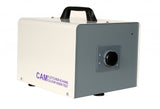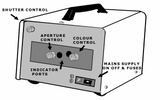The subject views pairs of small colored lights, reflected from a standard mirror which is supplied with each instrument; the mirror is at 3 metres and the task is to name the colors.
Typically, the names white, red and green are allowed, with yellow in clinical mode.
Note: There are two different reds, each called red, and two different greens, each called green.
THE NEED FOR LANTERN COLOR TESTS
Lanterns are established and practical means for detecting color vision defects, for clinical, aviation and marine purposes and instill confidence by resembling real tasks.
Naming small colored lights is required in transport and danger warnings.
TYPICAL USES
- Ensuring safety for aircraft pilots, mariners, drivers, railway staff and others.
- Detecting inherited anomalies of color perception. Up to 8% of males have these.
- Detecting and monitoring perceptual anomalies in pathological conditions.(Diabetes, cataract and varied retinal degenerations are typical examples.)
UK STANDARDS are set for Navy, Merchant Marine, RAF, and Civil Aviation use. Those set by Holmes-Wright lanterns for Air and Marine use are closely matched and used in the CAM, since the H/W lanterns are now not made. In addition, the CAM lantern provides an extra Clinical Mode in the same instrument.
Care is taken over matching colors, brightness and aperture sizes. Each CAM is issued with a spare lamp unit, easily replaced after 2,500 hours, for recycling, although lamp life is estimated at 4000 hours.
The Cam was developed from the 2002 prototype, with which Prof. R. Fletcher won a competition organised by the College and Association of Optometrists.
FEATURES INCLUDE:
Aviation & Clinical test colors
These are shown in a quiet room with illumination between 80 and 200 lux.
Marine tests
Official tests by The Coastguard and Maritime Agency test centers normally use a darkened room with the candidates dark adapted. This situation is imitated with the CAM lantern.
Clinical tests
The Holmes/Wright standard colors and apertures are used, plus YELLOW confusion lights, useful for detecting anomalous tri-chromats, the less distinct degrees of defect.
Electrical supply is 240 volts from mains, via fuses with a stabilized transformer.
A 35 watt cool beam bulb uses 11.8 volts, in a purpose-built lamp unit, which is calibrated for luminescence and color temperature. This unit is easily replaced after 2,500 hours use.
A spare lamp unit & the standard mirror are issued with the CAM, to ensure correct use.
All periods of use and short warm up periods are logged. (Appendix A of the manual.)
The instruction manual explains all methods of use, giving examples of different responses by a variety of subjects. Background information and suggestions as to publications of use are included.
Controls
One manual knob sets the required apertures, another changes the colors.
A shutter manually uncovers the colors, normally for about TWO seconds.
Subjects should respond by naming the colors within FIVE seconds.
Cat No: 800 Fletcher-Evans CAM Lantern
Comes with brand new Mirror and all original accessories offered by manufacturer, in very good condition






